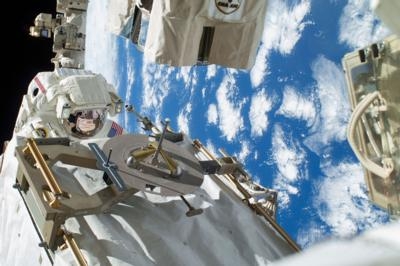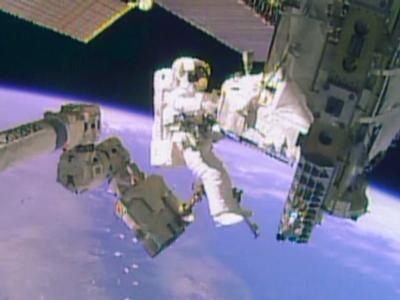Fri, Dec 27, 2013
Cooling System Now Considered To Be 'Fully Operational' Following Repairs
Spacewalkers Rick Mastracchio and Mike Hopkins completed a second spacewalk to install a spare ammonia pump module on Christmas Eve. The U.S. Quest airlock began repressurization at 1423 EDT Tuesday signaling the official end of their spacewalk.

Tuesday’s main tasks included the removal and installation of a spare pump module. The first task was to remove the spare pump module from the space station’s External Stowage Platform-3. After that was completed, the module was bolted to the S1 truss and connected to Loop A of the station’s external Active Thermal Control System.
Hopkins attached himself to the Canadarm2 and took a ride to the worksite. Mastracchio tethered himself to the station and translated to the S1 truss to assist his partner. Japanese astronaut Koichi Wakata operated the Canadarm2 from inside the Destiny laboratory. While doing the connection work, the duo demated ammonia fluid lines from a jumper box that enabled ammonia flow during the repair spacewalks. After experiencing some difficulty disconnecting a fluid line the spacewalkers reported seeing ammonia flakes escaping a valve. As a precaution, mission controllers asked the spacewalkers to inspect their spacesuits for possible ammonia contamination. Once they were back in the Quest airlock the duo conducted more ammonia decontamination procedures on their spacesuits. All four fluid lines were successfully reconnected to the newly installed pump module restoring ammonia flow.
Afterward, Hopkins and Mastracchio completed electrical connections to the pump module. Power was successfully restored to the ammonia pump module. Flight controllers in the Mission Control Center at NASA's Johnson Space Center in Houston successfully restarted the new pump Tuesday night. The pump module controls the flow of ammonia through cooling loops and radiators outside the space station, and, combined with water-based cooling loops inside the station, removes excess heat into the vacuum of space. The new pump now is considered fully functional.

The duo was originally scheduled to finish the installation work on Monday before mission controllers detected a spacesuit configuration issue at the end of Saturday’s spacewalk, in which the spacewalkers removed a faulty pump that experienced a problem with its internal flow control valve Dec. 11.
The suspect pump was removed from the starboard truss and parked in a temporary location on the station’s Mobile Base System rail car where it can stay until at least next June. Managers decided an extra day of preparation was necessary to get a backup spacesuit ready for Mastracchio.
(Pictured: Top: NASA astronaut Rick Mastracchio participates in the first Expedition 38 spacewalk designed to troubleshoot a faulty coolant pump on the International Space Station. Bottom: Astronaut Mike Hopkins prepares to attach himself to a foot restraint on the Canadarm2 outside the International Space Station. NASA images)
More News
Aero Linx: Space Medicine Association (SMA) The Space Medicine Association of the Aerospace Medical Association is organized exclusively for charitable, educational, and scientific>[...]
Jamming Denotes emissions that do not mimic Global Navigation Satellite System (GNSS) signals (e.g., GPS and WAAS), but rather interfere with the civil receiver's ability to acquir>[...]
Aero Linx: Warbirds of America The EAA Warbirds of America, a division of the Experimental Aircraft Association in Oshkosh, Wisconsin, is a family of owners, pilots and enthusiasts>[...]
"From New York to Paris, this life-size replica of the Webb Telescope inspired communities around the world and, in doing so, invited friends and families to explore the cosmos tog>[...]
Hold-In-Lieu Of Procedure Turn A hold-in-lieu of procedure turn shall be established over a final or intermediate fix when an approach can be made from a properly aligned holding p>[...]
 ANN's Daily Aero-Linx (04.17.24)
ANN's Daily Aero-Linx (04.17.24) ANN's Daily Aero-Term (04.17.24): Jamming
ANN's Daily Aero-Term (04.17.24): Jamming ANN's Daily Aero-Linx (04.18.24)
ANN's Daily Aero-Linx (04.18.24) Aero-News: Quote of the Day (04.18.24)
Aero-News: Quote of the Day (04.18.24) ANN's Daily Aero-Term (04.18.24): Hold-In-Lieu Of Procedure Turn
ANN's Daily Aero-Term (04.18.24): Hold-In-Lieu Of Procedure Turn




